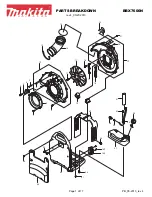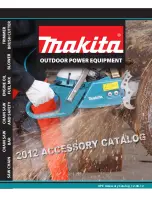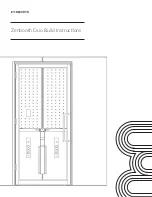
3
Know your equipment
. Read and understand the opera-
tion manual and labels affixed to the unit. Learn it’s appli-
cation and limitations as well as the specific potential haz-
ards of your equipment.
ALWAYS WEAR SAFETY GOGGLES.
Ground all equipment.
This unit is equipped with an ap-
proved 3 prong grounding-type plug. The green ground
wire should never be connected to a live terminal.
Use the Proper Extension Cords.
Use the following
guide for choosing the proper extension cord:
Wire Maximum Length
18 Ga. - 10 feet
16 Ga. - 25 feet
14 Ga. - 50 feet
12 Ga. - 100 feet
Avoid Dangerous Environments.
Do not use this unit in
damp locations or expose it to rain. This equipment should
be used in a location with mechanical ventilation that pro-
vides at least four air changes per hour. This equipment
should not be used near open containers of flammable
liquids.
Disconnect Unit from Power Supply Before Servicing
.
An electrical shock hazard is present when the unit is dis-
assembled or the cowling is removed.
Repair Damaged Parts.
Do not operate the unit with a
defective part. Repair unit to proper operating conditions.
Use Recommended Accessories.
Follow the instruc-
tions that accompany all accessories. Improper use of ac-
cessories may damage equipment or create a hazard.
Use Caution When Connecting or Disconnecting.
Im-
proper usage may result in refrigerant burns (frostbite). If
a major refrigerant leak occurs, proceed immediately to a
well ventilated area. The hoses included with this unit are
supplied with couplers that, when closed, prevent refriger-
ant vapors from venting when disconnecting from the
automobile.
Only Use the 37880 with the Correct Refrigerants.
The 37880 Series is only approved for R-134a
Operate the Unit within the Design Environment.
The
37880 was designed to operate in a temperature range
from 40°F to 120°F. The unit should also not be operated
in a wet location.
WARNING!
Refrigerant, in liquid and vapor form, is a po-
tentially hazardous material. Please consult the manufac-
turer’s Material Safety Data Sheet for additional informa-
tion and adhere to the following safety guidelines:
Avoid breathing high concentrations of vapors.
Use with sufficient ventilation to keep operator expo-
sure below recommended limits, especially in en-
closed and low lying areas.
Avoid contact of liquid refrigerant with the eyes and
prolonged skin exposure.
Wear goggles and protective gloves.
Do not attempt to operate this unit above 120°F ambi-
ent temperature.
Do not allow refrigerants to contact open flame. Re-
frigerant decomposition in a flame results in phosgene
gas. Breathing phosgene gas can be fatal.
FIRST AID:
If high concentrations of refrigerant are in-
haled, immediately remove the victim to fresh air. Call a
physician or emergency medical technician. Keep calm. If
not breathing, give artificial respiration. If breathing is diffi-
cult, give oxygen. Do not give epinephrine or similar
drugs.
EYE:
In case of liquid contact, immediately flush eyes
with plenty of water. Call a physician.
SKIN:
Flush with water. Treat for frostbite, if neces-
sary, by gently warming the effected area.
CAUTION!
All refrigerant hoses, recovery tanks, refriger-
ant lines, the 37880, and other vessels containing refriger-
ants should be handled as if under high pressure.
CAUTION!
Should be operated by certified personnel.
CAUTION!
Avoid breathing A/C refrigerant and lubricant
vapor or mist. Exposure may irritate eyes, nose and
throat. To remove HFC-134a from the A/C system, use
service equipment certified to meet the requirements of
SAE J2788. Additional health and safety information may
be obtained from refrigerant and lubricant manufacturers.
CAUTION!
Do not pressure test or leak test HFC-134a
service equipment and/or vehicle air conditioning systems
with compressed air. Some mixtures of air and HFC-134a
have been shown to be combustible at elevated pres-
sures. These mixtures, if ignited, may cause injury or
property damage. Additional health and safety information
may be obtained from refrigerant and lubricant manufac-
turers.
General Safety Instructions


































